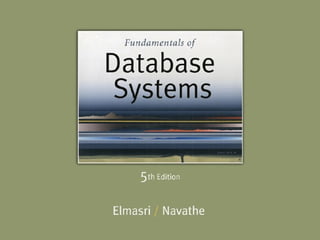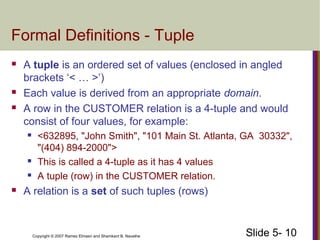The document discusses the relational data model and constraints. It provides definitions and examples of key concepts in the relational model including relations, attributes, tuples, domains, schemas, keys, and integrity constraints. Specifically, it defines the different types of constraints - key constraints, entity integrity constraints, and referential integrity constraints - and provides examples to illustrate how they are applied in a relational database schema.



















![Slide 5- 20Copyright © 2007 Ramez Elmasri and Shamkant B. Navathe
Characteristics Of Relations
Notation:
We refer to component values of a tuple t by:
t[Ai] or t.Ai
This is the value vi of attribute Ai for tuple t
Similarly, t[Au, Av, ..., Aw] refers to the subtuple of
t containing the values of attributes Au, Av, ..., Aw,
respectively in t](https://image.slidesharecdn.com/chapter05-180408135125/85/Chapter05-20-320.jpg)

![Slide 5- 22Copyright © 2007 Ramez Elmasri and Shamkant B. Navathe
Key Constraints
Superkey of R:
Is a set of attributes SK of R with the following condition:
No two tuples in any valid relation state r(R) will have the
same value for SK
That is, for any distinct tuples t1 and t2 in r(R), t1[SK] ≠ t2[SK]
This condition must hold in any valid state r(R)
Key of R:
A "minimal" superkey
That is, a key is a superkey K such that removal of any
attribute from K results in a set of attributes that is not a
superkey (does not possess the superkey uniqueness
property)](https://image.slidesharecdn.com/chapter05-180408135125/85/Chapter05-22-320.jpg)





![Slide 5- 28Copyright © 2007 Ramez Elmasri and Shamkant B. Navathe
Entity Integrity
Entity Integrity:
The primary key attributes PK of each relation schema
R in S cannot have null values in any tuple of r(R).
This is because primary key values are used to identify the
individual tuples.
t[PK] ≠ null for any tuple t in r(R)
If PK has several attributes, null is not allowed in any of these
attributes
Note: Other attributes of R may be constrained to
disallow null values, even though they are not
members of the primary key.](https://image.slidesharecdn.com/chapter05-180408135125/85/Chapter05-28-320.jpg)

![Slide 5- 30Copyright © 2007 Ramez Elmasri and Shamkant B. Navathe
Referential Integrity
Tuples in the referencing relation R1 have
attributes FK (called foreign key attributes) that
reference the primary key attributes PK of the
referenced relation R2.
A tuple t1 in R1 is said to reference a tuple t2 in
R2 if t1[FK] = t2[PK].
A referential integrity constraint can be displayed
in a relational database schema as a directed arc
from R1.FK to R2.](https://image.slidesharecdn.com/chapter05-180408135125/85/Chapter05-30-320.jpg)












